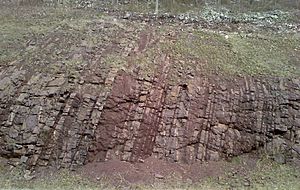Juniata Formation facts for kids
Quick facts for kids Juniata FormationStratigraphic range: Late Ordovician |
|
|---|---|

Outcrop on U.S. Route 522 at Blacklog Narrows southeast of Orbisonia, Pennsylvania.
|
|
| Type | sedimentary |
| Underlies | Oswego Formation and Tuscarora Formation |
| Overlies | Bald Eagle Formation |
| Thickness | 400–1,125 ft (122–343 m) |
| Lithology | |
| Primary | sandstone, siltstone, shale |
| Location | |
| Region | Appalachian Mountains |
| Extent | Maryland, Pennsylvania, Tennessee, Virginia, and West Virginia |
| Type section | |
| Named for | Juniata River in Pennsylvania |
| Named by | Darton and Taff |
The Juniata Formation is a special type of rock layer found in places like Pennsylvania and Maryland. It formed a long, long time ago, during the Ordovician period. This was about 440 to 485 million years ago!
You can often find it in the Appalachian Mountains. This rock layer usually forms gentle slopes. It sits between two other rock layers that make tall, rocky ridges: the Tuscarora Formation and the Bald Eagle Formation.
Contents
What is the Juniata Formation?
The Juniata Formation is made up of different kinds of rocks. These include siltstone, shale, and sandstone. The rocks can be grayish-red or greenish-gray in color.
Sometimes, you might see crossbedding in the sandstone. This means the layers of sand were deposited at an angle. It also contains some subgraywacke and protoquartzite. These are types of sandstone that contain different minerals. You might also find small bits of conglomerate, which is rock made of larger pebbles cemented together.
The Juniata Formation is similar to another rock layer called the Queenston Shale. The Queenston Shale is found in western Pennsylvania.
How did the Juniata Formation form?
Scientists believe the Juniata Formation formed mostly on land or in shallow parts of the ocean. It was created from sediments that washed down from mountains. These mountains were pushed up during an ancient event called the Taconic orogeny. An orogeny is a process that builds mountains.
What fossils are in the Juniata Formation?
It's rare to find actual body fossils in the Juniata Formation. However, you can often find trace fossils. Trace fossils are not parts of an animal's body. Instead, they are signs of its activity. These can include things like ancient tracks or burrows left by creatures that lived long ago.
How old is the Juniata Formation?
The Juniata Formation is from the Upper Ordovician period. This means it was formed between 488.3 and 443.7 million years ago. It sits directly on top of the Bald Eagle Formation in Pennsylvania. In Maryland, it rests on the Martinsburg Formation. The Tuscarora Formation is found right above it.
What is the Juniata Formation used for?
The rocks from the Juniata Formation are quite useful! They are a good source of material for building roads. They can also be used as riprap. Riprap is a layer of large rocks used to protect shorelines or slopes from erosion. Sometimes, these rocks are also used as building stones.
Images for kids
-
The white rock (left) is the Tuscarora Formation. It sits on top of the red rock (right), which is the Juniata Formation. This is at the Narrows in Bedford County, Pennsylvania.
-
This rock sample shows slickensides. These are smooth, polished surfaces on rocks. They are caused by rocks rubbing past each other along a fault line. This sample is from a roadcut near State College, Pennsylvania.



